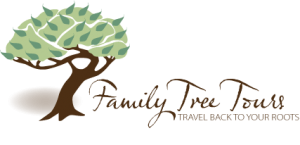So we sent everyone out via train to visit their hometowns last Wednesday and usually we have to wait until they come back in the evening (or next day) until we find out how their day went, but this time Matthias and I were taking one couple to visit their hometowns too. We headed first to Holte where we were met by the local town historian and a member of the Osnabrueck Genealogy society. We visited first the 800+ year old church, which was beautiful. The wooden cross above the altar was a “triumphal cross”  from about 1200, which means it has the symbols of Matthew, Mark, Luke & John at the four cross points. This wooden cross was only found in the 1970’s up in the attic under some junk, the Christ figure had been hanging in the church but since the year 2000, the cross and body of Christ was restored and placed again above the alter. Amazing. Before we left they rung the 600 year old bell for us.
from about 1200, which means it has the symbols of Matthew, Mark, Luke & John at the four cross points. This wooden cross was only found in the 1970’s up in the attic under some junk, the Christ figure had been hanging in the church but since the year 2000, the cross and body of Christ was restored and placed again above the alter. Amazing. Before we left they rung the 600 year old bell for us.
After the church we climbed (and I mean climbed) a hill to visit one of the most beautiful, peaceful  cemeteries I have ever seen. German cemeteries are something to see but this one high up on the hill was really something. Of course you won’t find old gravestones there but that is a story for another time. We learned how villagers from the surrounding area would have walked up and down this hill to get to church, probably several miles each way. Needless to say, I would imagine they would have been in shape!
cemeteries I have ever seen. German cemeteries are something to see but this one high up on the hill was really something. Of course you won’t find old gravestones there but that is a story for another time. We learned how villagers from the surrounding area would have walked up and down this hill to get to church, probably several miles each way. Needless to say, I would imagine they would have been in shape!
Then after lunch we were off to visit old farmsteads. At lunch the historian had given Ray & Ann (tour members whose hometown we were in) a map of the village from 1786 which showed the farmhouse numbers and where they were located. Then off to visit the houses. We went to the first where an older lady who lived on the land the house had been standing, invited us in for cake and coffee and she showed us some pictures of the old farm house. Her husband was a cousin to the last descendants who lived in Ray’s farmhouse and when they died he got the farm. The house went into disrepair until a couple bought it and moved it stick by stick and built a new home from it. We also went there and they allowed us to see the outside which would have looked how it did previously.
What was really cool about this day (well many things were) but the day before when we visited the Detmold freilichtmuseum we learned about the farm system for this area of Germany, which described how the small farmers would have been subject to a landlord and they would have had to pay rent/taxes with their time and crops to the landlord. So when we were visiting in the  countryside around Holte, one of the ladies who had joined us took us to her parents farm, her delightful parents in their 90’s had bought the farmstead their family had leased for many years and renovated it This would have been a small farmer’s house and you could see how these farms were scattered around a few kilometers from each other. She then took us down the road some to show us what had been the landlord’s
countryside around Holte, one of the ladies who had joined us took us to her parents farm, her delightful parents in their 90’s had bought the farmstead their family had leased for many years and renovated it This would have been a small farmer’s house and you could see how these farms were scattered around a few kilometers from each other. She then took us down the road some to show us what had been the landlord’s house. Down a long, tree lined lane and surrounded by a water moat was where the nobleman would have lived and who owned the surrounding countryside and all the small farmers worked the land for him. We saw the history we had heard about the day before. Of course the landlord’s house is not owned by a landlord any more, just a rich family I would suspect.
house. Down a long, tree lined lane and surrounded by a water moat was where the nobleman would have lived and who owned the surrounding countryside and all the small farmers worked the land for him. We saw the history we had heard about the day before. Of course the landlord’s house is not owned by a landlord any more, just a rich family I would suspect.
All in all, a great day and we learned a lot and really helped Ray picture how his ancestor would have lived.
